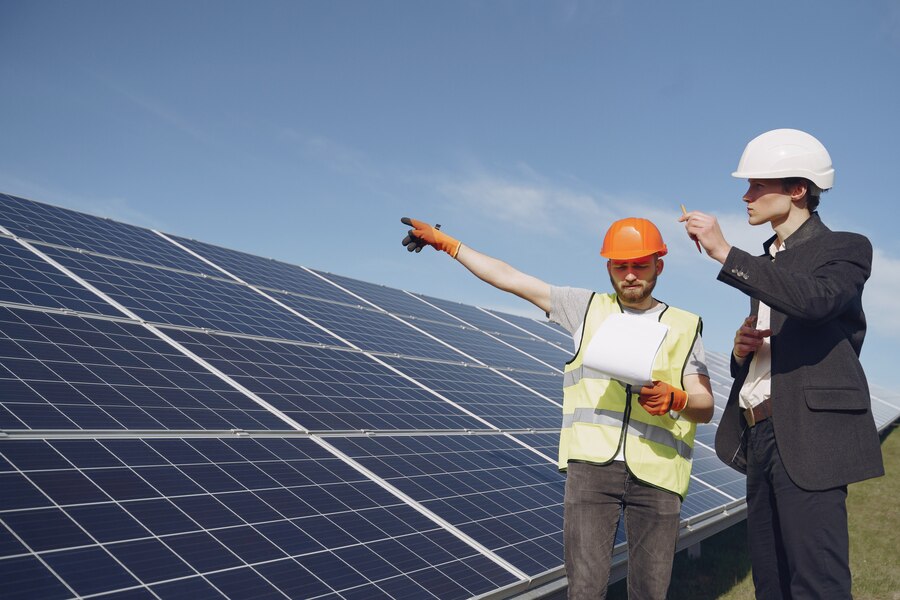
“From Sunlight to Electricity | The Installation of Solar Panel Systems”
- October 27, 2023
- 0
In the current period of increasing environmental awareness and the search for sustainable energy sources, solar power systems have become a bright light for producing power sustainably. Solar energy is essential to the shift to a more environmentally responsible future since it is clean, plentiful, and practically endless. One of the most important steps in creating a more sustainable and greener future is installing solar panel systems.
Components of Solar Panel Systems
solar panel system installation is an intricate assemblage of several parts, each of which is essential to the production and use of renewable energy. The principal constituents consist of:
The inverter transforms direct current (DC) produced by the solar panels into alternating current (AC), which is suitable for usage in the majority of homes.
Mounting Structure
To optimize sun exposure, solar panels must be mounted on rooftops, in the ground, or as solar trackers. These installations require a strong structure.
Batteries (optional)
Batteries serve as a means of storing excess electricity for use at a later time, particularly on cloudy or nighttime days.
Wiring and Electrical Components
To link the panels, inverter, and batteries and provide a safe and effective system, proper wiring and electrical components are necessary.
Procedure for Installation
Installing a solar panel system requires careful planning and execution, usually done by qualified specialists. Here is a detailed explanation of the installation process:
Site evaluation
To determine the location’s solar potential, a site evaluation is carried out prior to installation. Shade, angle, and available space are among the factors taken into account.
Design and Permitting
After the site is evaluated, a unique solar system design is produced. The size of the inverter, the quantity and configuration of solar panels, and other system elements are all included in this design. Permits that are required are also acquired.
Roof Preparation
In order to install solar panels on a rooftop, the structure must be strengthened, any necessary repairs must be made, and a secure attachment for the mounting structure must be made.
Installation of the Panels
The solar panels are firmly fixed to the ground or rooftop mounting structure. For optimal energy generation, alignment and spacing must be followed precisely.
Inverter and Electrical Wiring
The solar panels are connected to the inverter by electrical wiring, which is positioned close to the inverter. A safe and code-compliant installation is guaranteed by a certified electrician.
Installation of Batteries
Installing and connecting batteries to the system is optional if energy storage is needed.
Grid Connection
The solar panel installation is typically wired into the electrical grid. This makes it possible to export extra energy to the grid and pull energy from it in the event that solar production is insufficient.
Final Testing and Inspections
To make sure the system complies with requirements, utility companies and local authorities may carry out tests and inspections. To make sure the system is operating at its best, extensive testing is also carried out.
Advantages of Installing Solar Panel Systems
Cost savings
Installing solar panels can lower electricity bills dramatically. In certain situations, homeowners can even make money by selling extra energy they produce back to the grid.
Benefits for the environment
Because solar energy is clean and renewable, it lessens reliance on fossil fuels and greenhouse gas emissions.
Energy Independence
By having more control over their energy source, solar panel owners are less susceptible to power interruptions and changes in energy pricing.
Enhanced Property Value
Solar-equipped homes get a higher asking price when they go up for sale because they are more appealing to purchasers.
Government Incentives
To stimulate the installation of solar panels and lower its cost, several governments provide tax breaks, rebates, and incentives.
Obstacles and Things to Think About
Although solar panel systems have many benefits, there are a few things to keep in mind and problems to be aware of:
Initial Cost
Although long-term savings frequently balance this expense, buying and installing a solar panel system might have a significant upfront cost.
Site Suitability
Not every place is suitable for the installation of solar panels. Local laws, roof condition, and shading can all have an impact on the viability and efficacy of a system.
Maintenance
Although solar panels don’t require much upkeep, they do need to be cleaned and inspected on a regular basis to guarantee optimal performance.
Energy Storage
The cost and maintenance requirements increase if a battery system is wanted.
Conclusion
A revolutionary step toward a future with greater sustainability and environmental responsibility is the installation of a Commercial solar panel system solution in lahore Solar energy is becoming a more viable and appealing alternative for both businesses and homes as costs come down and technology progresses. We can lessen our dependency on fossil fuels, save energy prices, and help the environment by using the sun’s power. Installing solar panels is an investment in our communities and houses’ long-term health as well as the environment.









